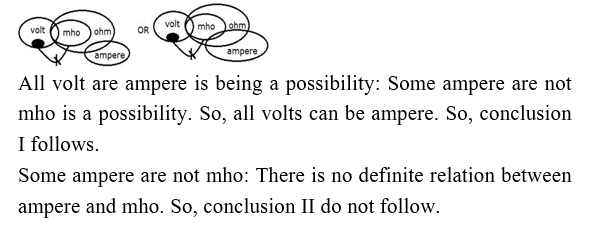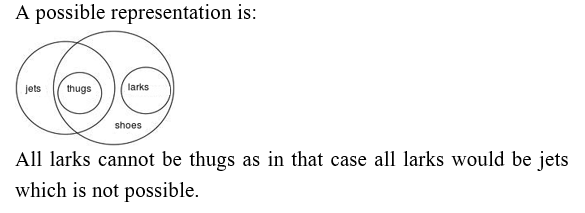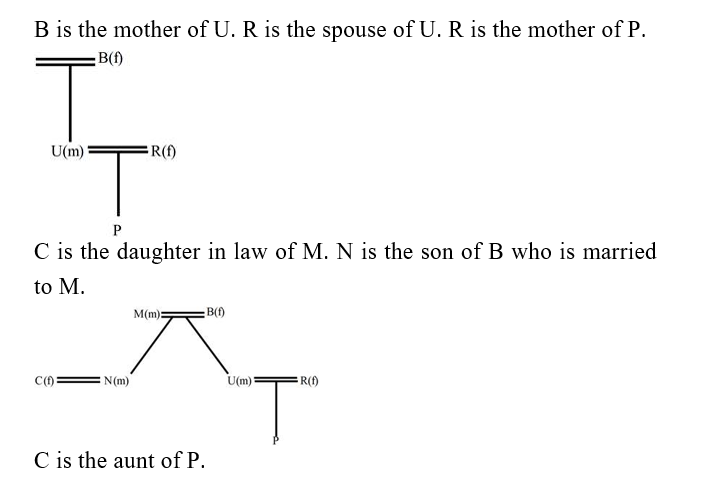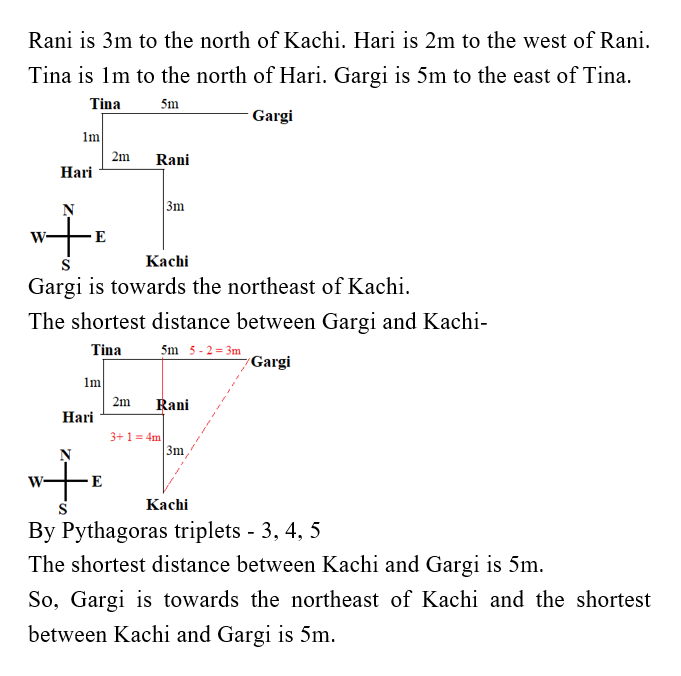Question 1:
In a certain coded language, '98 43 65' is written as 'for happy life', '76 21 54 43' is written as 'and life goes on' and '65 54 32' is written as 'sad and happy', then how 'goes to' is coded if "87" is written as "to''?
एक निश्चित कोड भाषा में, '98 43 65' को 'for happy life' के रूप में लिखा जाता है, '76 21 54 43' को 'and life goes on' के रूप में लिखा जाता है और '65 54 32' को 'sad and happy' के रूप में लिखा जाता है, यदि "87" को "to'' के रूप में लिखा जाता है, तो 'goes to' को किस प्रकार कोडित जाएगा?
Question 2:
In the question given below, three statements are given followed by two conclusions. You have to take the given statements to be true even if they seem to be at variance from commonly known facts. Read the conclusions and decide which of the given conclusions logically do not follow from the given statements disregarding the commonly known facts.
नीचे दिए गए प्रश्न में तीन कथन और उसके बाद दो निष्कर्ष दिए गए हैं। आपको दिए गए कथनों को सत्य मानना है, भले ही वे सर्वज्ञात तथ्यों से भिन्न प्रतीत होते हों। निष्कर्षों को पढ़िए और निर्धारित कीजिए कि दिए गए निष्कर्षों में से कौन-सा निष्कर्ष सामान्य रूप से ज्ञात तथ्यों की अवहेलना करते हुए दिए गए कथनों का तार्किक रूप से अनुसरण नहीं करता है।
Statements: All biscuits are cookies.
कथन: सभी बिस्किट्स, कूकीज हैं।
Only a few biscuits are cakes.
केवल कुछ बिस्किट्स, केक हैं।
All cakes are cupcakes.
सभी केक, कपकेक हैं।
Conclusions: I. Some cakes are cookies
निष्कर्ष: I. कुछ केक, कूकीज हैं।
II. Some cupcakes are biscuits
II. कुछ कपकेक, बिस्किट्स हैं।
Question 3:
In the question given below, three statements are given followed by two conclusions. You have to take the given statements to be true even if they seem to be at variance from commonly known facts. Read the conclusions and decide which of the given conclusions logically follows from the given statements disregarding the commonly known facts.
नीचे दिए गए प्रश्न में तीन कथन और उसके बाद दो निष्कर्ष दिए गए हैं। आपको दिए गए कथनों को सत्य मानना है, भले ही वे सर्वज्ञात तथ्यों से भिन्न प्रतीत होते हों। निष्कर्षों को पढ़िए और निर्धारित कीजिए कि दिए गए निष्कर्षों में से कौन-सा/से निष्कर्ष सामान्य रूप से ज्ञात तथ्यों की अवहेलना करते हुए दिए गए कथनों का तार्किक रूप से अनुसरण करता/करते है/हैं।
Statements: Only a few volt are mho.
कथन: केवल कुछ वोल्ट, म्हो हैं।
Each mho are ohm.
प्रत्येक म्हो, ओह्म हैं।
Very few ampere are ohm.
बहुत कम एम्पेयर, ओह्म हैं।
Conclusions: I. All volt are ampere is being a possibility.
निष्कर्ष: I. सभी वोल्ट के एम्पेयर होने की सम्भावना है।
II. Some ampere are not mho.
II. कुछ एम्पेयर, म्हो नहीं हैं।
Question 4:
In the question given below, three statements are given followed by two conclusions. You have to take the given statements to be true even if they seem to be at variance from commonly known facts. Read the conclusions and decide which of the given conclusions logically follows from the given statements disregarding the commonly known facts.
नीचे दिए गए प्रश्न में तीन कथनों का अनुसरण करते हुए दो निष्कर्ष दिए गए हैं। आपको दिए गए तीनों कथनों को सत्य मानना है, भले ही वे आमतौर पर ज्ञात तथ्यों से भिन्न हों। निष्कर्षों को पढ़ें और निर्धारित करें कि दिए गए निष्कर्षों में से कौन-सा निष्कर्ष सामान्यतः ज्ञात तथ्यों की अवहेलना करते हुए तर्कसंगत रूप से दिए गए कथनों का अनुसरण करता है।
Statements: All thugs are jets.
कथन : सभी ठग्स, जेट हैं।
No jet is a larks.
कोई जेट, लार्क्स नहीं है।
All larks are shoes.
सभी लार्क्स, शूज हैं।
Conclusions: I. All thugs being shoes is a possibility.
निष्कर्ष : I. सभी ठग्स, शूज होने की संभावना है।
II. All larks being thugs is a possibility.
II. सभी लार्क्स, ठग्स होने की संभावना है।
Question 5:
Directions: There are seven members in a family. B is the mother of U. R is the mother of P. C is the daughter in law of M. N is the son of B who is married to M. R is the spouse of U.
निर्देश: एक परिवार में सात सदस्य हैं। B, U की माता है। R, P की माता है। C, M की बहु है। N, B का पुत्र है, जो M से विवाहित है। R, U का जीवनसाथी है।
How is C related to P?
C, P से किस प्रकार संबंधित है?
Question 6:
Directions: There are seven members in a family. B is the mother of U. R is the mother of P. C is the daughter in law of M. N is the son of B who is married to M. R is the spouse of U.
निर्देश: एक परिवार में सात सदस्य हैं। B, U की माता है। R, P की माता है। C, M की बहु है। N, B का पुत्र है, जो M से विवाहित है। R, U का जीवनसाथी है।
How is R related to N?
R, N से किस प्रकार संबंधित है?
Question 7:
Directions: There are seven members in a family. B is the mother of U. R is the mother of P. C is the daughter in law of M. N is the son of B who is married to M. R is the spouse of U.
निर्देश: एक परिवार में सात सदस्य हैं। B, U की माता है। R, P की माता है। C, M की बहु है। N, B का पुत्र है, जो M से विवाहित है। R, U का जीवनसाथी है।
How is P related to M?
P, M से किस प्रकार संबंधित है?
Question 8:
Rani is 3m to the north of Kachi. Hari is 2m to the west of Rani. Tina is 1m to the north of Hari. Gargi is 5m to the east of Tina. What is the shortest distance between Gargi and Kachi and in which direction Gargi is with respect to Kachi?
रानी, काची के उत्तर में 3m की दूरी पर है। हरि, रानी के पश्चिम में 2m की दूरी पर है। टीना, हरि के उत्तर में 1m की दूरी पर है। गार्गी, टीना के पूर्व में 5m की दूरी पर है। गार्गी और काची के बीच की न्यूनतम दूरी कितनी है तथा काची के सन्दर्भ में गार्गी कौन-सी दिशा में है?
Question 9:
In the question below, a statement is followed by two conclusions based on the statement. Study the conclusions and select the correct option as the answer.
नीचे दिए गए प्रश्न में एक कथन के बाद कथन पर आधारित दो निष्कर्ष दिए गए हैं। निष्कर्षों का अध्ययन कीजिए और उत्तर के रूप में सही विकल्प का चयन कीजिए।
Statement: T < B = Q > J = V; U ≥ X = Q
Conclusion I. T < J II. U ≥ B
Question 10:
In the question relationship between different elements is shown in the statements. The statement is followed by two conclusions. Choose the correct option.
प्रश्न में विभिन्न तत्वों के बीच संबंध को कथनों में दर्शाया गया है। कथन का अनुसरण दो निष्कर्ष करते हैं। सही विकल्प का चयन कीजिए।
Statement: nn ≤ yy; qq = zz ≥ rr; rr > nn = oo
Conclusions: I. nn < qq II. zz ≤ yy





